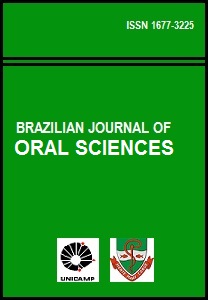Abstract
Aim: The aim was to compare the clinical wear of two compomers (F2000; 3M/ESPE and Dyract AP; Dentsply) placed in occlusal cavities in permanent molars within a two-year follow-up period using an indirect method of evaluation. Methods: Twenty-one patients, whose treatment plans included Class I restorations, were selected. Each patient received two occlusal Class I restorations in permanent molars. One and 2 years after placement of the restorations, the 21 teeth restored with each material were submitted to wear evaluation. Polyvinylsiloxane impressions were taken and casts were made (baseline, 1 year and 2 years). The casts were classified by comparative evaluation using sets of 18 calibrated standard models (0 to 900 ìm), according to Leinfelder’s indirect method. Paired and unpaired t-tests were used for comparisons between the evaluations for the same material and between materials for each evaluation period, respectively. Results: The occlusal wear was higher afterAim: The aim was to compare the clinical wear of two compomers (F2000; 3M/ESPE and Dyract AP; Dentsply) placed in occlusal cavities in permanent molars within a two-year follow-up period using an indirect method of evaluation. Methods: Twenty-one patients, whose treatment plans included Class I restorations, were selected. Each patient received two occlusal Class I restorations in permanent molars. One and 2 years after placement of the restorations, the 21 teeth restored with each material were submitted to wear evaluation. Polyvinylsiloxane impressions were taken and casts were made (baseline, 1 year and 2 years). The casts were classified by comparative evaluation using sets of 18 calibrated standard models (0 to 900 ìm), according to Leinfelder’s indirect method. Paired and unpaired t-tests were used for comparisons between the evaluations for the same material and between materials for each evaluation period, respectively. Results: The occlusal wear was higher after 2 years than after 1 year (p<0.001). The t-test demonstrated that the wear values, after 1 year, were similar for both compomers (F2000=17.6 ìm and Dyract AP=12.8 ìm). However, after 2 years, F2000 restorations (40.6 ìm) suffered significantly more wear (p<0.05) than Dyract AP restorations (29.8 ìm). Although compomers performed similarly after 1 year, Dyract showed less occlusal wear after 2 years. All occlusal Class I compomer restorations presented more occlusal wear after 2 years, but were considered as clinically acceptable within the evaluation period. Conclusions: The mean wear values found for both compomers do not indicate the need for either repair or replacement of the restorations. 2 years than after 1 year (p<0.001). The t-test demonstrated that the wear values, after 1 year, were similar for both compomers (F2000=17.6 ìm and Dyract AP=12.8 ìm). However, after 2 years, F2000 restorations (40.6 ìm) suffered significantly more wear (p<0.05) than Dyract AP restorations (29.8 ìm). Although compomers performed similarly after 1 year, Dyract showed less occlusal wear after 2 years. All occlusal Class I compomer restorations presented more occlusal wear after 2 years, but were considered as clinically acceptable within the evaluation period. Conclusions: The mean wear values found for both compomers do not indicate the need for either repair or replacement of the restorations.The Brazilian Journal of Oral Sciences uses the Creative Commons license (CC), thus preserving the integrity of the articles in an open access environment.
Downloads
Download data is not yet available.

